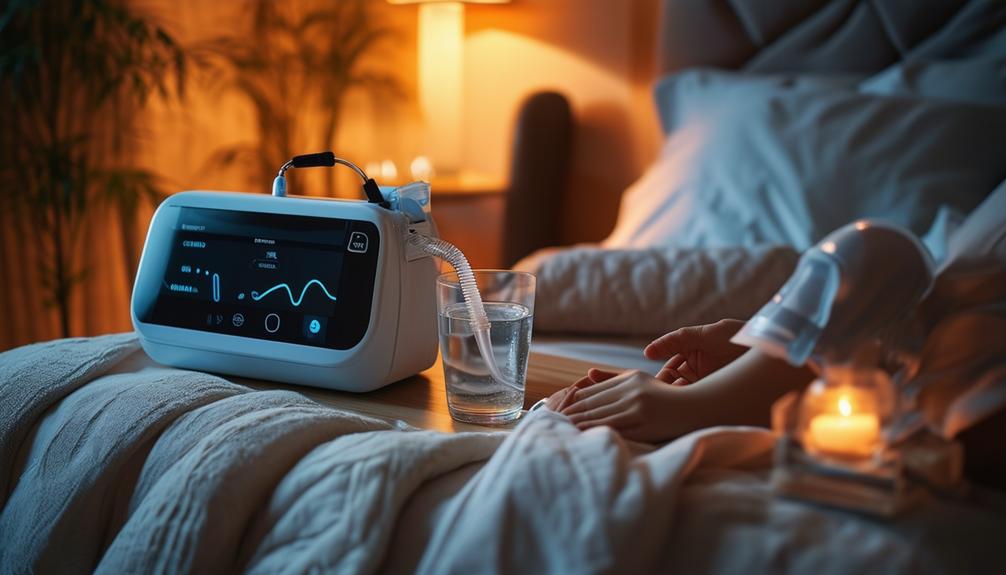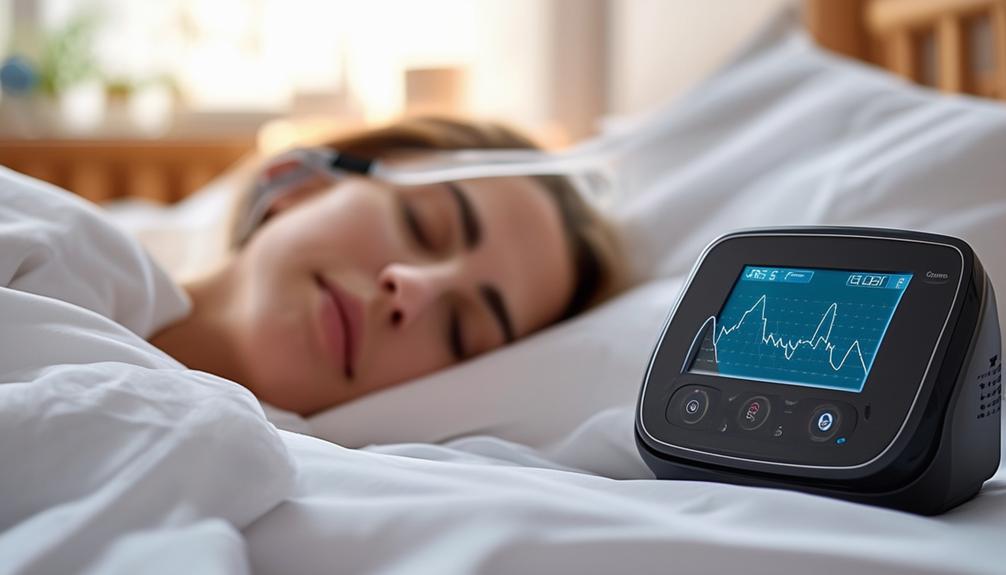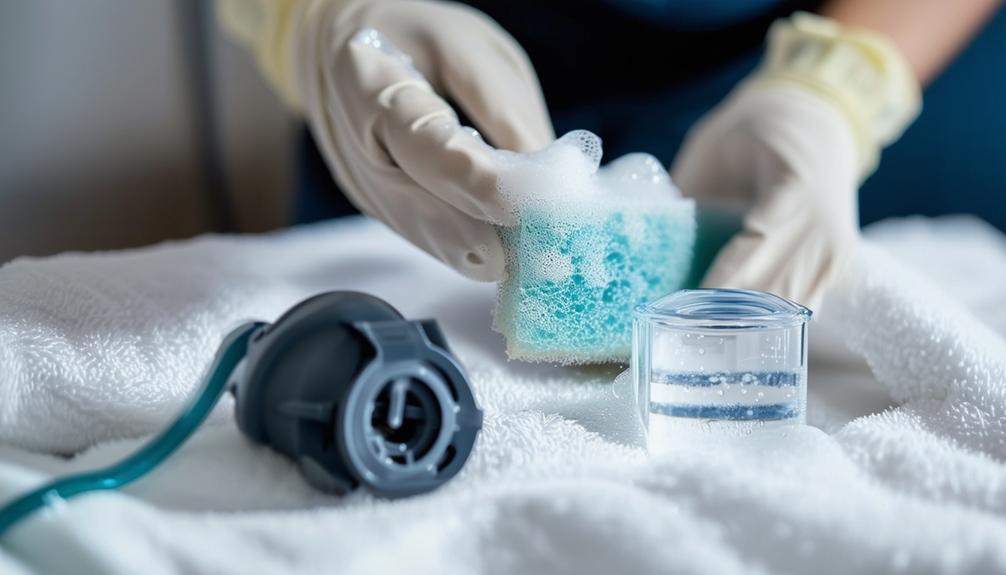Top 3 CPAP Tips for Beginners

Start by choosing the right CPAP mask based on your sleeping position and breathing habits. Nasal masks and pillows are ideal for side sleepers, while full-face masks suit mouth breathers or back sleepers. Gradually adjust the pressure settings to help your body acclimate to therapy. Begin with lower pressures, then slowly increase them under your healthcare provider's guidance to avoid discomfort. Regular cleaning is crucial for hygiene and therapy effectiveness. Clean your mask and water chamber daily with mild soap and warm water, and disinfect hoses weekly. By following these tips, you'll optimize your CPAP therapy experience effectively. Learn more valuable insights that could enhance your treatment further.
Noteworthy Details
- Choose a CPAP mask based on your sleeping position for comfort and effectiveness.
- Start therapy with lower pressure settings and gradually increase as you acclimate.
- Ensure a proper mask fit to prevent air leaks and discomfort.
- Clean your CPAP equipment regularly to maintain hygiene and therapy effectiveness.
- Follow pressure adjustment guidance from your healthcare provider for a smooth transition.
Choose the Right Mask
Selecting the appropriate CPAP mask is vital to guarantee both comfort and the effectiveness of your sleep apnea therapy. Your sleeping position greatly impacts the type of CPAP mask you should choose. Nasal masks, nasal pillows, and full face masks each cater to different preferences and needs.
For instance, nasal masks and pillows are ideal if you sleep on your side, providing a minimalist design that reduces pressure on your face. Conversely, full face masks are suitable for those who breathe through their mouth or sleep on their back, offering thorough coverage.
To make sure a proper fit, it's important to get the right mask size. An ill-fitting mask can lead to air leaks and discomfort, disrupting your therapy. Air leaks not only reduce the effectiveness of your treatment but also can be quite bothersome.
Consulting with a healthcare professional or CPAP supplier can help you find the best mask option tailored to your individual needs and sleeping habits.
Regularly clean and maintain your CPAP mask to ensure its longevity and the effectiveness of your therapy. A well-maintained mask reduces the risk of infections and maintains a proper seal, ensuring you get the most out of your treatment.
Gradually Adjust Pressure

Begin your CPAP therapy at a lower pressure setting to let your body gradually acclimate to the treatment. Starting with a lower pressure can greatly reduce discomfort, making it easier for you to adapt to wearing the CPAP mask.
As your body gets used to the CPAP therapy, you can gradually adjust the pressure settings, ensuring a smoother changeover and better overall experience.
Your healthcare provider will guide you on how to adjust the pressure settings on your CPAP machine. Gradual adjustment is essential to avoid any sudden discomfort that might impede your therapy adherence. By steadily increasing the pressure, you guarantee that your airway receives excellent support, which is essential for the effective treatment of sleep apnea.
Properly adjusting the pressure levels is a key component of personalized therapy. Everyone's needs are different, and learning how to tailor the pressure settings to yours will greatly enhance the effectiveness of your CPAP therapy.
Consistent, personalized adjustments not only improve therapy adherence but also provide you with the best possible outcomes for managing your sleep apnea. Remember, your healthcare provider is an important resource in this process, ensuring that your therapy is both comfortable and effective.
Maintain Regular Cleaning

After adjusting the pressure settings, it's essential to maintain regular cleaning of your CPAP equipment to ensure both hygiene and effective therapy. Neglecting this can lead to bacterial growth, infections, and diminished effectiveness of your treatment. To keep your CPAP equipment in top shape, adhere to the manufacturer's recommendations for cleaning schedules and methods.
Here are key steps to maintain hygiene and prolong the life of your equipment:
- Daily Cleaning: Clean your CPAP masks and water chambers daily using mild soap and warm water. Rinse thoroughly to remove any soap residue, which can cause irritation or allergies.
- Weekly Cleaning: At least once a week, disinfect your hoses and masks. Soak them in a solution of one part white vinegar to three parts water for 30 minutes, then rinse well. This helps eliminate any lingering bacteria or mold.
- Filter Maintenance: Depending on your CPAP model, clean or replace the filters as specified. Typically, reusable filters need a good rinse every two weeks, while disposable ones should be replaced monthly.
Frequently Asked Questions
What Are the Comfort Hacks for Cpap?
For CPAP comfort, make sure your mask fits well to avoid air leaks. Adjust humidity settings to prevent dryness. Nasal pillows can be a great alternative. Use chin straps and hose management tools to enhance comfort and reduce skin irritation.
How Do I Get the Most Out of My CPAP Machine?
To get the most out of your CPAP machine, juxtapose comfort with efficiency. Maintain a strict cleaning routine, guarantee proper mask fitting, and monitor data regularly. Optimize humidity levels, manage the hose, and keep up with software updates.
What Is the Best Sleep Position for a CPAP User?
For the best sleep position with CPAP, try side sleeping with proper pillow support and head elevation. Focus on body alignment and neck positioning. Stomach sleeping is challenging; back sleeping helps reduce gravity effects. Choose a supportive mattress.
What Should the Pressure Be on a CPAP Machine for a Beginner?
For beginners, pressure settings on your CPAP machine should typically start at 4-6 cm H2O. Machine calibration and CPAP titration, guided by your sleep study and doctor consultation, will help personalize pressure through airflow adjustments and pressure increments.
Conclusion
Adopting CPAP therapy can feel overwhelming, but you're not alone.
Did you know that 70% of new users report improved sleep quality within the first month?
By choosing the right mask, gradually adjusting pressure, and maintaining regular cleaning, you're setting yourself up for success.
Remember, consistency is key. Keep refining your approach, and soon, you'll likely experience the transformative benefits that so many others have.
Stay committed; your health is worth it.

